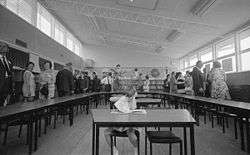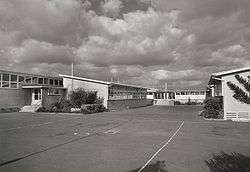Light Timber Construction schools

Light Timber Construction (or LTC) was the name given to a standardised architectural design used for the construction of hundreds of state school buildings in Victoria, Australia, between 1954 and 1977. LTC school buildings were designed for speed of construction, uniform appearance and low cost.[1] Many LTC school buildings are either being demolished, or refurbished and so intact original-condition examples are becoming rare.
History

Following the end of World War II, there was a sudden increase in the natural birth rate, or "baby boom", in Victoria, as well as a massive increase in immigration. This led to a sharp rise in demand for school places, which the Department of Education in Victoria was struggling to meet. In addition the Department had lowered the age of school admission to five years in 1946, and since the War there had was a substantial increase in students continuing into high school. A report commissioned in 1949 by the director of the Department of Education, Sir Alan Hollick Ramsay estimated that local high school enrolments would increase by 20,000 students over the next decade.[2] Simultaneously, on account of the war, there was a shortage of building materials and labour in Victoria. In response to this crisis prefabricated buildings were seen as a solution, with ex-military huts pressed into service along with imported buildings. Several hundred aluminium classrooms manufactured by the Bristol Corporation were imported from England for use throughout the state until the program was ended in the mid-1950s.[2]

Hollick recommended to the State Government that a standardised design for all state schools be adopted,[3] as such a design would reduce the expense in commissioning architects to individually design each school, and would allow school construction to proceed more efficiently whilst using less building resources. In the early 1950s the Department of Public Works developed the "Light Timber Construction" (or LTC) design.[4] A number of initial prototype schools were built in the LTC style, as it was tested and refined. An early example, still in existence, is the Croxton School in the Melbourne suburb of Northcote.[5] Initially codenamed the "Leighton School" and classed as "prototype six", this school was built in 1956 and provides an example of the refinement of the LTC design. By the end of the 1950s the standardised design had been used for seventeen new schools.[2]
The schools were built by a number of contractors: a contract in 1954 for £5,984 gave Swan Hill High School two LTC classrooms,[6] the same year Heywood Consolidated School had six LTC classrooms erected for £9,800.[7] Electrical works were in separate contracts, the 1955 contract for the electrical installation in six LTC classrooms at Heidelberg West State School was £375.[8] The LTC design was used for more than general classrooms: the 1957 contract for the erection of a trade annex in light timber construction and masonry veneer at Bairnsdale Technical School was for £16,478;[9] in 1962 a modified Domestic Arts wing was built at Mortlake High School in light timber construction with a concrete veneer for £23,713.[10]
From this period until 1976, hundreds of similar LTC school buildings were constructed by the Department of Education across Victoria. Whilst small design variations existed on different sites, and between primary and secondary schools, the overall construction method and aesthetic remained the same. Eventually, the demand for school places fell and the Department of Education resumed constructing state schools with individual designs.
Design features

Light Timber Construction schools, as the name suggests, were constructed using wooden framing. External walls are either clad in timber, sheet metal, brick, or cement tile (the most common option). Rooftops were always clad with corrugated iron, and supported by zig-zag steel rafters. LTC schools were always built as a single storey. Where multiple school wings were required, buildings were often linked with an iron covered-way in the case of primary schools, or a link corridor in the case of high schools.
LTC school buildings always consist of long central corridors, from which classrooms are constructed on either side. Typically, there will be a continuous span of classrooms on one side, whilst intervals will be left between clusters of classrooms on the alternate side, to allow for additional exits and natural light to penetrate the corridor. Occasionally, classrooms will only be constructed on a single side. Corridors typically have low ceilings (approximately 3 metres), and capacity for bags (primary schools) or lockers (high schools) to be stored along the walls. A long series of windows provides visual contact with classrooms.
Classrooms are typically entered through sliding doors from the corridor. The ceilings of classrooms are elevated above the corridor, and tilt away so that one row of windows connects the room with the corridor, whilst another row above provides natural light from outside. On the external side, either two or three horizontal rows of wooden-framed windows provide light from outside. LTC classrooms were typically furnished in a uniform way, with built-in blackboards and cupboards at the front of the room, fluorescent lighting from above, and venetian blinds on the windows. Most classrooms had polished wooden floorboards, which were later carpeted-over.
Criticism and future
Whilst the LTC design provided government with a cheap and efficient method for rapidly constructing schools, the design meant that buildings were hot in summer and cold in winter due to poor insulation, and were often viewed as being "industrial" and "sterile" fitting a "factory model" of schooling.[11] As methods of education has changed, modern educational specialists criticise the design of long corridors and rows of classrooms as being old-fashioned and uninspiring.[12] The low-set ceilings of LTC corridors tended to make these spaces dark, and many schools have undergone refurbishment so that the height of the corridor ceilings has been lifted, and skylights installed. Other schools opened out internal walls and added non-institutional furniture to create a more flowing and integrated environment.[13]
Owing to their cheap construction, and funding cuts that were made to education in the 1980s and 1990s, many LTC school buildings aged poorly, becoming shabby and run-down,[1] becoming extremely expensive to maintain as they were not intended to last more than 20 years.[14] In 2006 the Australian Education Union said that the cost simply replacing LTC schools is $1.9 billion, and would take 30 years at the then rates of Government spending.[15] The State Government's Victorian Schools Plan released in 2006 committed to rebuild or renew all government schools by 2017,[16] leading to many LTC school buildings being demolished or substantially renovated and modified. Consequently, intact examples of this school design in original condition are becoming very rare.
References
- 1 2 "School Buildings: Planning, Maintenance and Renewal". www.audit.vic.gov.au. 12 November 2008. Retrieved 2010-02-12.
- 1 2 3 Heritage Alliance (for Heritage Victoria) (October 2008). "8.2 Educating People" (PDF). Survey of Post-War Built Heritage in Victoria: Stage One. www.heritage.vic.gov.au. p. Page 25. Retrieved 2010-02-13.
- ↑ S. N. Gower. "Ramsay, Sir Alan Hollick (1895 - 1973)". Australian Dictionary of Biography Online. adbonline.anu.edu.au. Retrieved 2010-02-12.
- ↑ architectus. "The Permancy of School Facilities". www.architectus.com.au. Retrieved 2010-02-12.
- ↑ "Swinburne Image Bank: Leighton School". images.swinburne.edu.au. Retrieved 2010-02-12.
- ↑ "Public Works" (PDF). Victoria Government Gazette. gazette.slv.vic.gov.au. 8 October 1954. Retrieved 2010-02-12.
- ↑ "Public Works" (PDF). Victoria Government Gazette. gazette.slv.vic.gov.au. 25 February 1954. Retrieved 2010-02-12.
- ↑ "Public Works" (PDF). Victoria Government Gazette. gazette.slv.vic.gov.au. 23 February 1955. Retrieved 2010-02-12.
- ↑ "Public Works" (PDF). Victoria Government Gazette. gazette.slv.vic.gov.au. 7 August 1957. Retrieved 2010-02-12.
- ↑ "Public Works" (PDF). Victoria Government Gazette. gazette.slv.vic.gov.au. 15 August 1962. Retrieved 2010-02-12.
- ↑ Lisa Mitchell (28 August 2006). "Building boon". The Age. www.theage.com.au. Retrieved 2010-02-12.
- ↑ Victorian Auditor General Office. "Managing government school buildings in Victoria" (PDF). School Buildings: Planning, Maintenance and Renewal. audit.vic.gov.au. Retrieved 2010-02-12.
- ↑ Mary Featherston Design. "Wooranna Park Primary School project". www.featherston.com.au. Retrieved 2010-02-12.
- ↑ Australian Education Union (Victorian Branch) (2 November 2006). "News: Liberal Education Policy: A Missed Opportunity". www.aeuvic.asn.au. Retrieved 2010-02-12.
- ↑ Mary Bluett (27 September 2006). "Can schools rely on public-private partnerships?". www.greenleft.org.au. Retrieved 2010-02-12.
- ↑ "Unfinished business: Schools, strikes and funding". The Age. www.theage.com.au. 28 July 2007. Retrieved 2010-02-12.